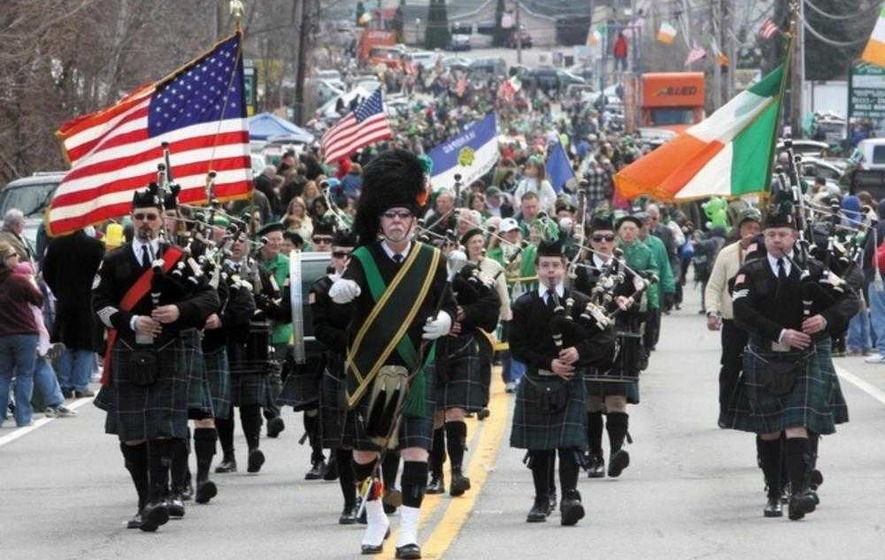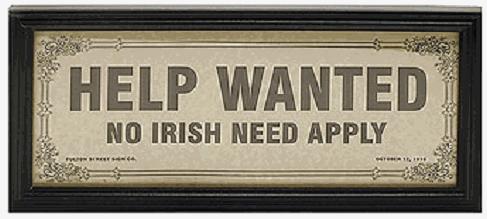
This article explores the issue of permanent residence for Irish immigrants in the United States. There are 50,000 immigrants from Ireland without a path to legalization. Yet, they remain invisible to much of the American public. The absence of a path to legalization creates a locked-in effect, preventing them from returning home, even in times of family emergencies. A political fix is needed.
Several years ago, I moved into a new neighborhood. Being a multiculturalism enthusiast, a family of five living across the street quickly caught my attention.
The wife was fair-skinned, short, with wavy red hair. The husband was dark, tall, with straight black hair. She was from Ireland. He was from Mexico. Their children’s pronunciations were unlike any version of English I had ever heard before.
I sensed one of my new neighbors lacked legal immigration papers.
During our initial chats, various descriptions of their work experience, entertainment preferences, travel tendencies, and community ties stood out.
As I have guided diverse immigrant families as a San Diego immigration lawyer to permanent residency over the past two decades, I have gained a lot of insights about the life style patterns of undocumented immigrants.
Two years afterwards they approached me for help, confirming my suspicion.
Irish Immigration Issues Today
One of the greatest misunderstandings in current immigration reform debates is that immigration is not just a Hispanic issue.
As a beacon of freedom and opportunity, the U.S. has long attracted individuals from countries throughout the world. Some do not have legal status to be here.
For instance, nearly 50,000 undocumented Irish immigrants live in the United States.
The majority live in big cities like New York, Boston, Chicago, and San Francisco.
Approximately 30,000 undocumented immigrants from Ireland live in New York City.
In the Bronx, considered by experts as the most populated Irish neighborhood of New York, about 40% of the Irish residents do not have green card status.
In Boston, a city in which 16% of the population claims Irish ancestry, there are an estimated 10,000 undocumented immigrants who were born in Ireland.
Like immigrants from other countries, they face “locked-in syndrome.” They cannot visit relatives abroad, even during times of family emergencies, or they risk denial upon their attempts to re-enter the United States.
Having overstayed their visas, the odds of visiting their homeland and then being allowed to return the U.S. is not possible.
A large percentage of Irish Immigrants work at low-wage, low-skilled jobs in the construction and building industries.
Many can only find employment through Irish community connections.
When driving, they avoid routes which are heavily policed. In short, they too live in the shadows, hoping to escape detection by law enforcement authorities.
Having served as a deportation defense and permanent residence lawyer for Irish Immigrants for more than two decades, I’ve learned first-hand about their need for comprehensive immigration reform.
In recent years, Irish-American immigration advocates have been outspoken about their compatriots’ need for a legislative fix.
They have organized delegations of undocumented workers to lobby U.S. elected officials in Washington, and they have participated in public marches for reform.
Yet, for the vast majority of the American public, undocumented Irish immigrants are invisible.
As one Irish immigrant explained in an interview with the Los Angeles Times, “From my experience, we’re not singled out. If someone’s driving down the street and they see five Mexican guys on one side and five Irish guys on the other, they’re going to think that the Mexicans are illegal, even though it could be the other way around.”
Like my two neighbors.
The wife from Ireland lacked immigration documents.

Early Irish-American Immigration History
For many, St. Patrick’s Day is a time for celebration throughout the U.S. It was not always acceptable to celebrate Irish heritage in America.
The public view of early Irish immigrants closely corresponds to sentiments toward Hispanic immigrants today. They were demonized as dirty, job stealing, poor, uneducated, low-skilled, uninvited invaders who were going to ruin America.
The Irish: The Illegal Immigrants Of Yesterday
Mario Lopez, The Daily Caller, March 17, 2011Historian Kevin Kenny:
The Irish immigrants were mostly unskilled, worked for low wages . . . Native-born workers worried that their own wages would decline . . . Many Americans also feared that the Irish would never advance socially but would instead become the first permanent working class in the United States, threatening the central principle of 19th-century American life: upward social mobility through hard work.
The Advertiser newspaper in Boston wrote of the Irish as “import[ing] their vile propensities and habits from across the water” and referred to children of immigrants (“anchor babies,” if you will) as “wretched offspring.”
The Chicago Post editorialized:
“The Irish fill our prisons, our poor houses . . . Scratch a convict or a pauper, and the chances are that you tickle the skin of an Irish Catholic. Putting them on a boat and sending them home would end crime in this country.”
The 1965 Immigration Act And Irish Immigrants
As noted in Lessons From 1965: Why Employment-Based Reform Is Xenophobia In Disguise, the 1965 Immigration And Nationality Act set in motion major shifts in the composition of immigrants coming to the United States.
Before 1965, the immigrant stream was largely European.
Under the old system, admission was based on an immigrant’s country of birth. Seventy percent of immigrant visas were granted to just three countries — the United Kingdom, Ireland, and Germany. Now, European-born immigrants (from all countries) are issued about 11% of total visas granted.
Before the 1965 Act, Ireland was allowed an annual allotment of 18,000. According to Department of State statistics, Irish immigrants only received 335 of the 531,463 visas issued in 2015.
The primary path to undocumented status for immigrants from Ireland differs from that of their Latino and Mexican counterparts. The majority are overstays, not entrants without inspection.
Many have been able to get their feet in the door legally via J-1 visas, which enables them to engage in work and study-based exchange programs. However, once here, they remain past their visa expiration dates – for the same purpose most Latinos enter with United States without permission: to find stable employment and build a secure life.
Despite the lower visa numbers issued to Irish immigrants, relative to the gains of of Latinos and other immigrants, Irish community activists and leaders consistently voice support for reform solidarity.
A few examples:
- Anne Anderson, Ambassador of Ireland to the United States, asserts U.S. immigration reform is “a multifaceted problem” that “also wears an Irish face.”
- In the view of Niall O’Dowd, co-founder of the Irish Lobby for Immigration Reform, “Every ethnic group brings their own strength to the debate.”
- Kieran O’Sullivan, an immigration and citizenship advisor for the Irish Pastoral Center located in Massachusetts, emphasizes Irish reform advocates can help bridge the cultural gap caused by “the us-versus-them mentality” towards Hispanic immigrants in the immigration debate.
Further, Anderson adds, the Irish-American plea has been a double one: to address the situation of the undocumented, and also to create some avenues created for legal entry in the future because “they’re obviously two sides of the same coin.”
Having settled in and established employment and family roots, undocumented Irish immigrants are at risk for deportation. Hence, their need for immigration reform and a full path to U.S. citizenship mirrors that of other, larger immigrant communities.

Irish Immigrants Join Push For Family Unity And Legalization
Keeping immigrant families together is not a one-ethnicity issue.
Too much is made of skin color by opponents, subtly and unconsciously. Tearing down such imagery, by expanding the contours of reform inclusion, should be a political priority.
As stressed in No Room For Segregation In The House Of Immigration Reform, overcoming this narrow view is critical to developing a political agenda which leads to comprehensive immigration reform.
Even though undocumented Irish immigrant totals may be small relative to the much larger figures of Latino immigrants, their potential significance should not be minimized.
In my view as a family unity defense and green card attorney, adding White immigrant faces in support of ending the separation of immigrants from their U.S. relatives is a step in the right direction.
Currently, the Pew Research Center estimates 600,000 undocumented immigrants living in the U.S. hail from Europe and Canada.
Developing a closer political alliance with Irish-American activists is not only tactically critical, but also strategically smart – on the road to building a broader coalition capable of achieving legislative success.
Immigration reform is an Irish issue.
It’s also a Latino issue.
And a Chinese issue . . . and a Filipino issue . . . and an Iraqi and Afghanistan issue . . . and a Black Caribbean and African issue . . . and . . .
United, our chances for victory are heightened.
Divided, well, need I say more?
By Carlos Batara, Immigration Law, Policy, And Politics




